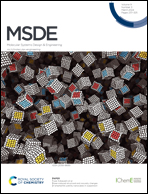Shear-induced structural and viscosity changes of amphiphilic patchy nanocubes in suspension
Abstract
Structure formation and rheological properties of amphiphilic patchy nanocubes in equilibrium and under shear were investigated using hybrid molecular dynamics simulations combined with multiparticle collision dynamics that consider hydrodynamic interactions. The relationship between complex self-assembled structures and the resulting macroscopic properties has not yet been examined because of the computational complexity these multiscale problems present. The number and location of solvophobic patches on the amphiphilic nanocubes were varied at several colloid volume fractions in the liquid regime. For a pure suspension of one-patch cubes, the nanocubes self-assemble into dimers in the equilibrium state because bonded one-patch cubes have no exposed solvophobic surfaces. At low shear rates, small dimers undergo shear-induced alignment along the flow direction. This results in shear-thinning accompanied by slightly higher shear viscosity (≈15%) than homoparticle dispersions of the same concentration. As the shear rate increases further, the suspensions exhibit Newtonian-like behavior until the cluster disintegrates, followed by shear thinning with breakdown into individual cubes. For binary mixtures of one- and two-patch nanocubes, the resulting cluster shapes, which include elongated rods and fractal objects, can be controlled by the patch arrangements on the two-patch cubes. Interestingly, despite the differences in the shape and resistance of the clusters, two different mixtures undergo a similar increase in the shear viscosity (≈35%) compared to the homoparticle dispersions, to essentially exhibit rheological behavior similar that of a pure suspension of one-patch cubes. Our findings provide new insights into the correlation between microscopic (design of patchy cubes), mesoscopic (self-assembled structures), and macroscopic (viscosity) properties, and are also valuable for identifying the synthesis conditions required to realize novel materials with the desired properties and functionalities.



 Please wait while we load your content...
Please wait while we load your content...